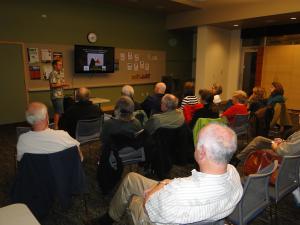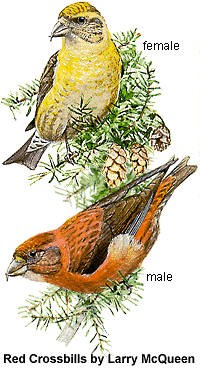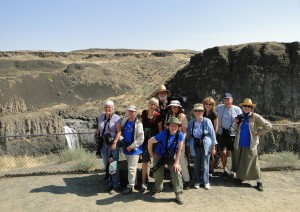Ken Brown led a two day ABC trip to the coast on Friday and Saturday, August 7-8. 11 birders gathered at the usual I-5/Hwy512 park and ride to head west, with the first stop at Brady Loop where a lack of water limited the shorebirding opportunities but where we did see a male N. Harrier, and at one stop had at least 4 calling Willow Flycatchers, Yellow and Wilson’s warblers and Common Yellowthroats of all ages in their confusion plumages moving about while we had the scopes aimed at a Bank Swallow on a wire with over a hundred other Tree, Violet-green and Barn swallows. Bank swallow was a new Gray’s Harbor county bird for many of us and was an e-bird rare bird alert sighting.
From there we were off to catch high tide at Bottle Beach where we donned our rubber boots and walked out to scope hundreds of Black-bellied plovers, Short-billed dowichers, Western sandpipers and scattered Least sandpipers, Semi-palmated plovers, Dunlin, and lots of gulls, Caspian terns, Brown pelicans and others to try in vain to ID a golden plover or semi-palmated sandpiper. A nice stop but nothing unusual for species. We did enjoy nice looks at a perched Olive-sided flycatcher.
Next at Tokeland we had lunch, searched the rock jetty for a different species of godwit, but settled for just 20 Marbled and 20 Whimbrel along with the quiz bird of the stop, a Red-throated loon that had hauled out on the rocks and grass and was just showing its head and neck. It seemed an out-of-place loon but Ken reminded us that unlike the rest of our loons RTLO has a more typical molt timing and was likely in molt and resting there this time of year.
On the way back a quick stop at North Cove gave us a chance to see Sooty Shearwaters flying by in good numbers, streaming north at an estimated 200/ minute at the outer edge of the breaking waves. Thousands of California gulls of various age groups were bathing in the river delta and loafing, feeding along with smaller numbers of Heermann’s and Western/GW gulls.
Next at Midway Beach we waded through the water over the road to get good looks at Least Sandpipers in the ponds nearly underfoot at the road edge. Highlights here were 12 Cinnamon teal on the ponds, a fly-by American bittern and at least 6 N. Harriers. We made it a fairly quick stop and headed for Westport.
At the inner jetty the expected 450 marbled godwits yielded no other species and after studying the gulls, cormorants and looking for other species on the water we headed for Westhaven SP. There we enjoyed great looks at good numbers of alcids from the bluff. We counted 20 Common murres, 30 Rhinocdros aucklets and 2 Pigeon guillemots as well as huge flocks of gulls over the mouth of the harbor and far off on Damon Point. We also added both species of turnstones there. A quick stop back at the marina at the mouth of the harbor gave us our first certain looks at Brant’s cormorant and a stop for dinner.
I picked up my car at Bottle beach and headed home while the rest of the group headed for their hotel. Diane Y-Q med the group in the morning and the rest of the story is hers:
Diane, Faye, Carol, and Laurel came over on day 2 of this beautiful weekend at the coast and met the group on the golf course, which of course was covered with golfers. We followed them to the jetty, which was a totally different experience than ever before with much of the end of the jetty covered with pelican guano and Brown Pelicans, almost like Westport! Some groups of Shearwaters were going by way out there, and Gulls flew everywhere, especially the Pelicans’ pet Heermanns. A drama played out on the beach as we noticed some people gathered around a beached Common Murre. Several of us walked over there to assess the situation. The Murre was in distress, but one of the people, a young woman, was very protective of it, and soon the others wandered off. The pelican may have been oiled or just dirty from being beached too long. Dogs were starting to show up, and the immediacy of its situation became apparent. Clarice, a bander who has handled many birds over the year, knew there was no close rehab facility and that getting the bird into deeper water was the best bet, but not possible where we were standing, as the tide was still coming in and would just re-beach the bird. This young woman then carried the bird to the end of the jetty (NOT an easy hike!) and down to the water on the opposite side and released it. We were gone by the time she got back, but we saw her start her return without the bird, so that was the best possible outcome of a bad situation.
Then off to the game range, where there was a surprise WILLET!!!! Hurray!! A first for any of us in that location. Plus a few of the expected peeps. The beach off the game range gave us breathtakingly close views of a couple dozen Red-Throated Loons in mixed plumages, offering a great lesson in molt for this little loon. They were so close it seemed we could touch them and were amazingly tolerant of humans!
Then off to Bill’s Spit and a really great surprise there: Someone has built a wooden staircase down to the beach so we no longer have to do the climb-and-jump thing! It was brand new and beautiful. We even had our group photo taken on it! We would love to know who’s responsible and thank them! We had our expected group of gulls and Caspian Terns out there and spent some time going through them as small bands of Peeps flew through as a distraction from time to time.
Best bird of the day (after the Willet, of course!) was at the Ocean Shores sewage ponds — A Franklin’s Gull! This very cooperative bird offered long views and many photos to be sure of its ID before the looming Peregrine got the group up again. A very good little side trip indeed!
David Marshall suggested our last stop at the Quinault casino beach, which apparently they had already stopped at before we met up with them early this morning, for a last look at a different tide, and it was gorgeous with a thin envelope of ground-level fog, making the tourists-on-horseback look like a thundering posse out to arrest Ken and Ryan! Close-up views of Sanderlings in both Basic and Alternate plumages as well as lots and lots of immature Semipalmated Plovers, Peeps, and Dunlin were highlights.
A great day with great weather!




